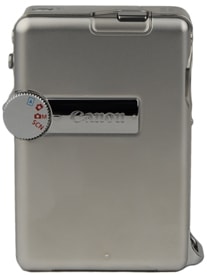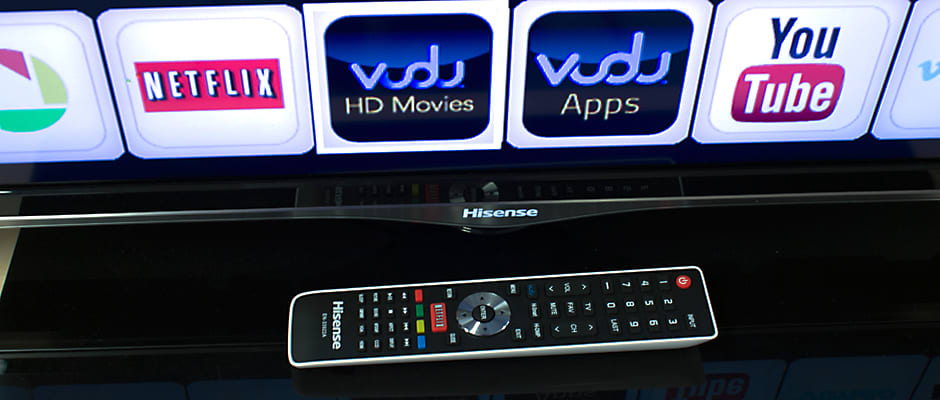Pros
Cons
Yet judging from the 55K610GW's performance, maybe Hisense needs a little more time in the oven to hold up under serious evaluation. Testing revealed truly atrocious picture quality that no amount of calibration could fix, and an impoverished feature set that makes the $800 price tag feel too high for this 55-inch contender.
Picture Quality
How is it that TVs this bad still exist?
On paper, the 55K610GW seems like a solid buy. A 55-inch smart TV for under a grand? Break out the fine china! Yet, unfortunately, that rationale rests upon the assumption that this TV produces at least a pleasing picture. I hate to break it to you, but that is far from the case.
Out of the box, everything is just set up wrong. In Theater mode—the one which should look the best—primary colors are undersaturated and secondary colors are skewed away from the proper tint. The Contrast setting is pushed too high, resulting in massive color temperature errors, and even the Brightness setting is off, revealing below-black details and compromising the integrity of black levels.
What does this mean for the viewer? It means that, pre-calibration, the Hisense 55K610GW just looks awful, and an informed calibration can only do so much to improve things. The TV's attempt to create a wide contrast ratio results in flat-looking colors during any kind of content, and its attempt to be the best and brightest on the showroom floor mean whites and grays are intoned with a blue tint.
Perhaps the biggest problem is this TV's complete lack of controls for Backlight or Gamma, which severely limits any chance of getting even a decent picture. The LEDs that line the perimeter of the TV bleed light when they aren't supposed to, so that a dark screen emits unwanted, blotchy light patches along the borders of the display. At factory settings, this Hisense has some of the worst uniformity issues I've ever seen.
We did test an acceptable contrast ratio, but it doesn't really translate well due to the TV's complete lack of subtlety in its presentation. Yes, it can emit a lot of light, and even produce a decent minimum luminance level, but the inability to transition smoothly and without error through the grayscale means that areas of shadow lack detail, while highlights suffer an ugly, blocky appearance.
The 55K610GW boasts a 120Hz panel, and the 120Hz Smooth Effect setting does tend to iron out some blurriness during motion.
Details like lines in faces, hatched brickwork, wood grain, and small text blur out of focus without motion assistance. The 120Hz processor improves blurriness, doesn't help the TV with color trailing or interlacing issues. Basically, the K610GW's LCD panel just refreshes too slowly to eliminate and recreate more complex patterns and brighter colors.
For those reasons, this TV's a bad choice for film- and video-based content, sports, action movies, nature documentaries, video games, even as a stand-in monitor for browsing the web. Only a calibration requiring an access code and secret menus might remedy this TV's errors, and good luck finding someone who knows Hisense's calibrator codes.
Design & Features
Samsung called...
... and it wants this TV design back. I'm not sure what the relationship is between Hisense and the South Korean company, but both of the Hisense TVs I've reviewed featured design elements that are suspiciously familiar. The plastic plate that joins the 55K610GW's panel to its boring, rectangular stand is literally the exact same plate used by every Samsung TV—either that, or it's Samsung doing the stealing. That said, the TV itself looks decent.
Edges hued in silver, reminiscent of Apple's brushed aluminum, ring the bezels around the screen. The bezels themselves—black, of course—are neither particularly thick nor particularly thin, but do provide a foil (as a kind of matting) to make non-black elements on screen seem even brighter and more colorful.
From a usability standpoint, the 55K610GW is pretty average. The usual on-set controls line the TV's right side, and are tucked away on the back, within easy reach. Hisense has included ample connectivity options as well, but the choice of placement strikes me as bizarre. A shared component/composite cluster can be found on the TV's left side—why it's not in back like every other model on the market, I do not know. Fortunately, there are four HDMI inputs and two USB inputs, as well as LAN and coax in, and digital audio out. That's plenty of flexibility for an entry-level TV.
The most interesting part of this whole TV package is the included remote—a long, button-filled wand with a black surface wrapped in a rounded, white backing. The contrasting elements create a sharp, but also playful-looking companion to the TV, which just ends up looking sort of dull by comparison.
{{ gallery "design" }}
Software & Interface
As a meal, this Hisense is a little low on calories.
The brand-name TV manufacturers shove a lot of content into their smart TVs. While the Hisense 55K610GW is, by literal definition, an internet TV with built-in WiFi, it doesn't boast nearly the spread of options we've seen on other smart TVs this year.
Pressing the Hi-Smart button on the K610GW's remote will bring up a rather paltry selection of apps. There's no browser, no sample media content, nor any sort of customizable pages or cable integration—stuff that's gradually becoming par-for-the-course.
Hisense's biggest app partner is undoubtedly Netflix, but you might also recognize Vudu Movies, Vudu Apps, Picasa, and the ever-present YouTube. "Vudu Apps" is not much of an app store, by the way. We've discussed our disgust with it before—it's very disappointing.
As for the menu interface, it's equally bare bones, though right in line with what we expect from entry-level TVs. Sub-menus for Picture, Audio, and Settings provide a scant approach to customizing your TV's image quality and sound output. The Picture menu is particularly lacking in more advanced calibration controls—something this TV is desperately wanting for.
{{ gallery "software" }}
The Finish Line
Avoid this Noid
The Hisense 55K610GW produces a decidedly sub-standard picture. If you've been shopping around and it seems like a huge value, take it from the experts: It's not. We agree that $800 for a 55-inch LCD seems awesome, especially if you're upgrading from a CRT or something, but there are better options from Vizio, Samsung, and even JVC.
For the same price or just a little more, there are TVs in the same size, with better smart features, and much better picture quality. Hisense is new, so we'll cut some slack, but we can't emphasize enough that this TV is only recommendable in smaller sizes where the glaring picture errors won't be as noticeable—or if you really just don't give a darn about picture quality.
Behind the Screens
The Hisense 55K610GW ($798) bombed almost all of our in-lab tests. We peer into the very basic mechanics of a television to observe how it handles the behind-the-scenes processing and light production required to create a picture on screen, and this Hisense had a plethora of problems. Out of the box, it sports very poor color accuracy, massive RGB balancing errors (color temperature), and even incorrectly set reference levels. After calibration, its overall performance was only marginally improved—and still quite bad.
Calibration
Doctor, here's a dull pencil and a mascara case. Operate!
While many high-end TVs offer the calibration controls necessary to alter their picture to a more perfect balance, the Hisense 55K610GW does not. Lacking controls for color management, white balance, gamma, and even backlight, improving the TV's performance through calibration was just shy of impossible. The pre-calibration settings were atrocious; the settings I wound up with were still a far cry from acceptable.

I started off calibrating from the 55K610GW's defaults in Theater mode, which automatically takes up the mantle of a User mode when even a single setting is altered. I calibrated the 55K610GW to theater lighting, and was forced to drop the Contrast control from 45 to 29 in order to approximate about 135 cd/m2 or 45 fL. Reducing Contrast also increased detail along the upper grayscale, and pushed the TV's gamma correction closer to the HDTV standard of 2.4.
Next, Brightness had to be fixed. In Theater mode, the TV's black levels are set incorrectly—elements technically "darker" than black show up during content playback. This is the opposite of setting Brightness too high, where shadow details are crushed.
The toughest part of the calibration process was the attempt to correct the 55K610GW's undersaturated colors. Lacking a color management system, I was tasked with increasing the Color control in an attempt to push the TV's red, green, and blue primaries into their proper locations—the secondary colors were all but beyond redemption. This required increasing Color from 45 to 69.
Overall, calibration resulted in a slightly-less-horrible picture, but essentially my efforts were wasted trying to tweak the 55K610GW's settings.
Contrast Ratio
Decent contrast, but for a price
Contrast ratio is a measure of a TV's maximum light output divided by its minimum luminance level. The resulting number is often a telling descriptor of how immersive a TV's picture will be. However, in the case of the 55K610GW, its decent contrast ratio comes at a price: loss of middle-element details.

We measured a minimum luminance level of 0.068 cd/m2 , which is quite good for an LCD, and an equally sparkling peak brightness of 310 cd/m2 . The result is a contrast ratio of 4559:1, which is really good for an entry-level TV like this one. Unfortunately, that intense brightness caused serious errors in the TV's grayscale and gamma, errors which could only be corrected by lowering the Contrast control as detailed in the Calibration section.
Viewing Angle
Average for this price and type
Horizontal viewing angle can be a staunch determinant of a TV's overall positioning flexibility. The 55K610GW's panel doesn't swivel upon its stand, so its viewing angle integrity is more important than if it did. Unfortunately, like many LCDs, sitting very far from center results in picture degradation.

We tested a total viewing angle of 26°, or ±13° from the center to either side of the screen. This is fine for one or two (friendly) people, but any more and viewers are going to see blacks becoming gray, whites darkening, and blue blotches from the edge-LEDs bleeding into picture elements. This is a below average result within the industry, but it's to be expected for this price range.
Grayscale Error
From worse to bad
A television's grayscale is the combined black/gray/white created by its red, green, and blue sub-pixels from minimum to maximum output. The charts below document the amount of sub-pixel balancing errors found within each IRE step of the grayscale, from 0 (black) to 100 (white) IRE. The grayscale is broken into 10 steps (sometimes 20) to aid in calibration, and the amount of error found is expressed in DeltaE.

The 55K610GW's initial results were problematic. We tested a total pre-calibration DeltaE of 13.42, with major errors beginning at 30 IRE and increasing exponentially over the next six steps. This Hisense doesn't include specific grayscale (white balance) controls, and thus we weren't able to manually correct the grayscale in any fashion. However, the post-calibration settings resulted in a slightly lesser DeltaE of 10.42—still really bad, but not as bad. To put it in context, most TVs come out of the box with a DeltaE between 1 and 4—where below 3 is considered "acceptable."
RGB Balance
All over the place
The reason for the grayscale errors above is an improper RGB balance. This refers to where, within the grayscale signal, the TV's red, green, and blue sub-pixels lie. Ideally, a TV's sub-pixel balance will describe three flat, tightly-knit lines that are neither emphasized or de-emphasized across the signal range. Of course, that was not the case with the 55K610GW.
Our initial readings revealed a terrible RGB balance—while green stays relatively even, red plummets drastically across the grayscale while blue rockets into the heavens. The three sub-pixels are "tied" to one another, meaning increases in red's signal presence (to match green's) would reduce blue's... if there were controls to do such a thing. The controls are not present, however, so the final "calibrated" result was not much better than where it started.
Gamma Correction
Better, but not perfect
Gamma is the measure of how a display handles its increase in luminance from black to white—essentially, everything in the middle. The ideal gamma setting for HDTVs is 2.4 (previously 2.2), which describes the incremental space in steps from one level of luminance to the next. Prior to calibration, the 55K610GW tested with a gamma sum of 2.18, which is lower than ideal, but not terrible—it simply means the TV brightens too quickly. After calibration, we measured a gamma sum of 2.44, which is quite a bit closer to the 2.4 gamma ideal.

Color Gamut
Move along, folks. Nothing to see here.
The 55K610GW's pre- and post-calibration color production is very poor. The TV lacks a color management control, meaning only the very crude Color control can be used to adjust the TV's color space. Pre-calibration measurements revealed that the TV's white and gray were tinted with blue, its green and red points were undersaturated, its blue point was heavily oversaturated, and the resulting secondary colors (cyan, magenta, and yellow) were all off-tint.

We test each refrigerator using the same standardized battery of tests. This allows us to directly compare performances to figure out how each fridge excels—and where it falls short.
The ramifications here are that no content is going to look as good as it could. Some colors will be flat and dull-looking, blue will be much too vibrant and bright, and millions of secondary and tertiary colors will be a mix of dull, overemphasized, or simply the "wrong" color. Needless to say, this does not make for good picture quality.
Meet the tester
Lee was Reviewed's point person for most television and home theater products from 2012 until early 2022. Lee received Level II certification in TV calibration from the Imaging Science Foundation in 2013. As Editor of the Home Theater vertical, Lee oversaw reviews of TVs, monitors, soundbars, and Bluetooth speakers. He also reviewed headphones, and has a background in music performance.
Checking our work.
Our team is here to help you buy the best stuff and love what you own. Our writers, editors, and experts obsess over the products we cover to make sure you're confident and satisfied. Have a different opinion about something we recommend? Email us and we'll compare notes.
Shoot us an email

